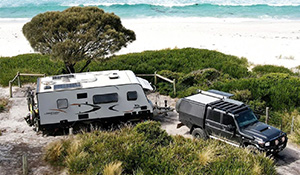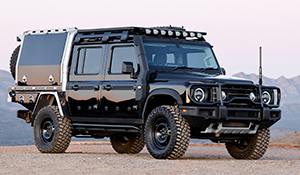Vehicle Test – 2017 Toyota Prado Kakadu
The Toyota Prado is the Japanese car maker’s medium-sized off-roader and one of the most popular and capable 4x4s on the market in Australia.
For those who don’t know, the Prado as a vehicle, in all but name, dates to the mid-1980s, but what we know as a Prado was released in 1996 as the Prado 90. It was Toyota’s response to Mitsubishi’s highly successful Pajero. That vehicle became the Prado 120 in 2002, and from 2009 it’s been the Prado 150, with interim updates along the way. There have been a few short-wheelbase variants but they weren’t very popular here and were eventually discontinued.
In late 2015, the engine was changed for a 2.8L turbo-diesel and, for the first time, a six-speed automatic transmission was offered to replace the previous model’s five-speed unit.
Today’s Prado comes with a choice of petrol or diesel engines, manual or automatic transmission and there are four trim specifications – GX, GXL, VX and Kakadu. Not all combinations of trim are available with all engines or transmissions and we have a full description later in this review.

What is it?
Our tester is the most expensive Prado, a turbo-diesel automatic Kakadu, and we had it for 10 days, driving it on-road, off-road, across dirt roads and even some city commuting.
The basic design of the Prado has been unchanged since the mid-1990s – Prado 90. There’s a separate chassis, live rear axle, independent front suspension, rear-mounted spare, long-range fuel tank and low range. There are variants of the Prado called the Altitude that shift the spare under the body, deleting the second fuel tank, largely for the European market but also sold here.
Prados are such a familiar shape they’re almost invisible, but Toyota has done a decent job of keeping the 150 reasonably fresh with new headlights, DRLs and slight changes to the bodywork. If you really want a different look then there’s a world of accessories for Prados. And there’s a new model coming later this year, images of which have already started appearing online showing LandCruiser 200-derived headlights and a new grille.

What’s the interior like?
When I got into the Prado it was immediately after having spent some in a Ford Everest, and I thought I’d been transported back to the 1990s. Big, clunky buttons everywhere, no flowing lines…really, in 2017? But then I began living with the car and started to appreciate the usability of it, if not the beauty. It’s much better to have buttons than touchscreen-for-everything, particularly for an off-road vehicle.
All the controls are well laid out, and easy to use. Starting from the bottom of the centre stack, there are the off-road controls, such as your locking diffs, then the climate control, and then infotainment. The try-hard faux-wood isn’t to everyone’s taste, but all should appreciate the way the interior just works. Even the mats are quality rubber with a bit of a lip, so I didn’t even bother with the aftermarket mats I generally use for press cars.
The second-row seats are fore/aft adjustable, there’s also the usual seatback angle adjustment, and there’s even a three-way split of sorts rather than the usual 40:60. The Kakadu offers heated and cooled second-row seats, and a 12v socket for those in the back. Both front row seats have rear seat pockets which are mesh so you can see what’s in there. All three seats have child restraint points, and the outer two have ISOFIX.

If you want more load space the second-row folds down in three parts for more room, but it’s not a totally flat floor.
The third-row folds into the floor and is, on the Kakadu electrically operated. There are no child restraints on the third-row, and once in place the space behind the third-row seats is pathetic, you’d struggle to fit a loaf of bread sideways and theres no way it’ll handle anything like a weekly shopping run – unlike, say, the LC200 or Ford Everest. At least there are handy slots for tie-downs, which is great for flexibility.
The electrical seat folding system for the third row is prone to pausing and is slow; I think I’d rather ditch the electrics to save weight and cost. Lighting is good, and there’s a 220v socket, too. No worries about the spare wheel access point because it hangs off the back door. Speaking of which, there’s no right answer for which rear door design is best, there are pros and cons for all, so the Prado’s swing-open unit is fine. You can ensure it stays open on slope by twisting the strut.

What’s the infotainment like?
The Kakadu runs Toyota’s standard infotainment unit that covers the basics but looks and feels a bit dated. There are no super-cool and useful features; the sat-nav works and has traffic alerts, but not much more. One good trick is that it can read text messages, and the voice control works well. The sat-nav works but has rather old blocky graphics and isn’t the most usable. There are, however, some nice customisation options for things like the front/rear parking sensors, unlocking and headlamp display.
You can pull up some information on the driver’s dash display such as a digital speedo, but it’s not as integrated with the main display as it could be.

What’s the Toyota Prado Kakadu like to drive?
The Prado is an easy, comfy drive. The suspension is, like all Prados, very soft. You can easily pitch the nose down or up when braking or accelerating, but on the plus side, speedbumps become non-existent. No Prado is quick, but there’s sufficient power and the all-wheel-drive system ensures you’ll never need worry about wheelspin.
Visibility is generally good all round, parking is easy, but the rear-mounted spare does intrude a bit on rear visibility. The reversing camera is at best average in size and quality, but does show turning lines. The Kakadu also has front and rear park sensors which help. The turning circle is 11.6m, which is about average for class.
You certainly wouldn’t call the Prado over-powered, but it will lumber along nicely enough. It grips well up until the limit of its tyres, turning in reasonably neutrally and happy to use what power it has to get out of the corner. However, while competent it’s boring and uninvolving – there’s very little feedback through the steering, the engine is willing but dutiful and while the soft suspension ensures traction is never lost, there’s a lot of body roll through corners. As for cruising on the highway, the adaptive cruise works well, the engine is reasonably quiet at cruise and the Prado is a comfortable, relaxed place to be for long trips. The adaptive cruise control doesn’t work down below about 20km/h, which is less than ideal in stop/start traffic.

The Prado does dirt roads very well thanks to its suspension and all-wheel-drive system. You’ll really need to work hard to lose traction under brakes, around corners or out of corners. It’s not an exciting drive, lacking the power and precision of handling required to think about rally car cliches, but it’s very, very competent which is about all most buyers of this type of vehicle are interested in.
Now, I am quite happy to say that the Prado is the best off-roader in its segment, noticeably more effective off-road than any of its peers, such as Everest, MU-X, Pajero Sport, H9 or Pajero.
There are several reasons for this, and Toyota’s superb traction control is one. It’s simply fantastic, as we’ve found in the LC200 and HiLux. The way it instantly brakes a wheel almost before it spins is incredible, and helps the Prado walk up hills that other cars need four times the speed to ascend. Crawl Control is impressive, too. On test, I had the Prado cross-axled up a hill and not even Toyota’s traction control would pull it forwards, foot to the floor and no progress. So I engaged Crawl Control and…the car just inched itself up the hill at a snail’s pace as if by magic, seemingly manufacturing traction where no other car could find it.

Then we have suspension flex. Toyotas have always had good flex, and the Prado’s suspension is both more supple and longer-travel than its peers, so it has all four wheels on the ground for longer and there’s less rocking of the car which would lead to a loss of traction. Fully independent suspension does have ground-clearance advantages though. The Kakadu has the cross-linked KDSS (Kinetic Dynamic System) which further improves suspension flex, as does the VX model.
And there’s more. The Kakadu has a rear cross-axle locker, which is not unusual. But what is unusual is that when it is engaged brake traction control works on the front axle, and works well. With Fortuner or Pajero Sport or H9, for example, I recommend that drivers pretty much forget the rear locker as traction control on all four wheels is better than a rear locker with an open front diff. But with the Kakadu you get the best of both worlds, and that’s yet another significant advantage in its off-road armoury.
Still more. The engine braking is adequate with a 36:1 crawl ratio, but Crawl Control does a great job of descending hills, better than any human. The centre diff can be locked, which is what you want for hill-climb performance and peace of mind; I’ve yet to find any ‘clever’ centre diff system that is more effective than a simple lock. And if you need to, you can easily unlock the centre diff in low range to improve the turning circle, for example when maneuvering in a campsite or around a fallen tree.

As it’s a Torsen with that effective brake traction control you still have a significant degree of off-road capability too. The Toyota Prado remains the medium-wagon benchmark for off-road performance, and I don’t see the others catching up any time soon. One feature the Prado offers but isn’t very effective is MTM, or Multi Terrain Monitor, a 360-degree camera view of the car – see below in Safety for photos. It’s not effective because the screen resolution isn’t good enough to pick out stumps or ruts, so you can’t read the ground well enough to drive effectively. The Prado is also the best showroom-floor off-road tourer in its segment. The spare tyre is on the back door, so it’s always accessible. There’s an 87L main tank and 63L sub-tank to make a total of 150L – aftermarket tanks would be an expense of around $1500 for other cars, and may require purchase of an expensive and heavy rear wheel carrier to make space. A second battery can be fitted under the bonnet, a rarity these days. And there’s every accessory you could possibly want for the car too. Prados are widely used for off-road touring for all these reasons. The only weak point is the 2500kg tow rating, but that’s plenty for a camper trailer.

What about safety features?
The Prado scored 35.98/37 in 2015 to realise a 5-star rating. All models get a reversing camera, but beyond that there’s not much in the way of safety equipment; you need to get to VX before you see front parking sensors and only the Kakadu has the sort of stuff we’ve come to expect as par for the course at this price point, like blind spot monitoring and rear cross-traffic detection. The reversing camera quality is a bit below par for 2017. The two outer seats do get ISOFIX and there are three child restraint points. Overall, Prado could do better for safety.
What do we think?
The Prado is unquestionably the best mid-sized off-road touring wagon both in terms of capability and modifiability, and it’s got great resale too. On the flip side, it is not the most modern, or the best value, or the best tower, and is a rather boring drive. I’d recommend it for people wanting a nice safe choice for an off-roader, but as a city SUV there are many better options out there, not least Toyota’s own Kluger.
The Prado has ruled the medium-4X4 touring wagon segment for some time. Compared to its competitors the vehicle is pricey, the infotainment is a bit behind the times, towing is not a strong point and models lower down the range lacks safety features, but the Prado remains a great all-rounder with unsurpassed off-road and touring capability that set a standard none of the rest of the market seem able to approach.

2017 Toyota Prado Kakadu
Pricing $83,490 plus onroad costs
Warranty three-years, 100,000 kilometres
Safety: 5 star ANCAP 35.98/37 rating for 201
Engine 2.8-litre four-cylinder turbo-diesel
Power 130kW at 3400rpm
Torque 450Nm at 1600-2400rpm
Transmission six-speed automatic
Drive all-wheel drive, low range, locking rear differential, adaptive terrain system
Dimensions 4930mm (L); 1885mm (W); 1845mm (H)
Turning circle 11.6m
Ground clearance 220mm
Approach/ramp/departure angles 32 / 22 / 25 degrees
Wading 700mm
Seats Seven
Spare full-sized alloy on door
Tare weight 2435kg
GVM 3000kg
Towing 2500kg braked, 250kg TBM, 750kg unbraked
GCM 5475kg
Fuel Tank 87+63 (total 150 litres)
Thirst 8.0L/100km

PRICING AND RANGE
There are four trim ranges, two engines and two transmissions. Here are the versions:
- GX – manual or auto, diesel, 5 or 7 seat;
- GXL – manual or auto diesel or auto petrol, 7 seat;
- VX – auto, diesel or petrol, 7 seat; and
- Kakadu – auto, petrol or diesel, 7 seat.
Below are the key features, excluding cosmetic garnishes. All prices exclude on-road costs.
Prado 150 GX
$52,900 (diesel, manual), $54,990 (diesel, automatic) – 7 seats add $3500
- Five seats (seven is an option);
- Trailer Sway Control;
- Reversing camera;
- Cruise control;
- 220v rear socket;
- Hill Start Assist (auto only);
- Downhill Assist Control (auto only); and
- 17″ wheels.
Prado 150 GXL
$59,900 (diesel, manual), $61,990 (diesel, automatic), $60,990 (petrol, automatic)
- Seven seats standard;
- Satnav;
- 9 speakers;
- Climate control with three zones;
- Rear parking sensors;
- Alarm;
- Side steps; and
- Tinted windows.
Prado 150 VX
$73,990 (diesel, automatic), $72,990 (petrol, automatic)
- KDSS (Kinetic Dynamic Suspension System);
- LED headlamps;
- 18″ wheels;
- Rain sensing wipers;
- Leather-accent seats;
- Heated front seats;
- Power steering wheel adjustment;
- Front parking sensors;
- 17 speakers;
- DAB+ digital radio; and
- Improved infotainment unit.
Prado 150 Kakadu
$84,490 (diesel, automatic), $83,490 (petrol, automatic)
- Rear cross-traffic alert;
- Blind spot monitor;
- Pre-crash safety system;
- Adaptive cruise control;
- Blu-Ray/DVD for rear passengers;
- CRAWL control;
- Multi-Terrain Monitor;
- Rear cross-axle differential lock;
- Rear height-adjustable air suspension;
- Multi-Terrain Select;
- Moonroof;
- Toolbox; and
- Memory position for driver’s front seat.









